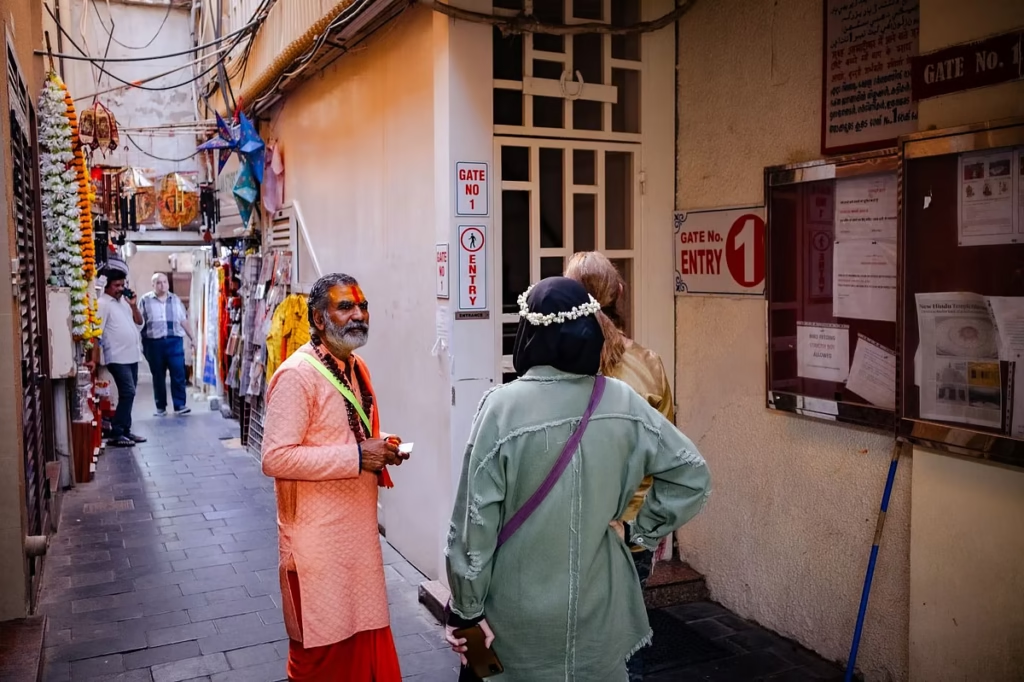Dubai, known for its towering skyscrapers, luxury shopping, and vibrant nightlife, is also home to a rich cultural and spiritual heritage. Among its many historical landmarks is the Bur Dubai Hindu Temple, a place of great religious significance that has stood the test of time. Nestled in the heart of Old Dubai, this temple serves as a sanctuary for Hindu worshippers and a fascinating attraction for visitors who want to explore the city’s diverse cultural fabric.
A Historical and Cultural Icon
The Bur Dubai Temple has been an integral part of Dubai’s religious and cultural landscape for over a century. It was established in the early 1900s by the Hindu community, long before Dubai emerged as a global economic hub. Over the years, the temple has not only served as a place of worship but has also stood as a testament to Dubai’s commitment to inclusivity and religious harmony.
Located in the bustling Meena Bazaar area near Dubai Creek, the temple is tucked away in the narrow, vibrant lanes of Old Dubai’s traditional markets. Its presence in a predominantly Islamic country highlights the UAE’s values of tolerance and coexistence. Despite Dubai’s rapid urbanization, the temple has remained a deeply cherished place of devotion, offering solace and spiritual guidance to thousands of devotees.

A Place of Worship and Community

The Bur Dubai Hindu Temple is dedicated to several Hindu deities, including Lord Shiva, Lord Krishna, Goddess Durga, and many others. Devotees visit daily to offer prayers, light incense, and participate in religious rituals. The temple follows traditional Hindu customs, with morning and evening aartis (prayer ceremonies) that create a deeply spiritual and uplifting atmosphere.
The temple becomes particularly lively during Hindu festivals such as Diwali, Navratri, and Janmashtami. On these occasions, thousands of worshippers gather, chanting hymns, offering prayers, and taking part in grand celebrations. The temple also conducts religious discourses and bhajans (devotional songs), which bring the community together in devotion and celebration.
Beyond religious activities, the temple also plays a significant role in community service. Many volunteers dedicate their time to organizing charity initiatives, free meal programs, and cultural events that support those in need. The temple stands as a hub of unity, where people from different backgrounds come together to experience a sense of belonging and peace.
Architecture and Unique Features
Unlike the large and ornate temples found in India, the Bur Dubai Hindu Temple is relatively small yet exudes a powerful spiritual presence. Its simple yet sacred interiors provide an ideal setting for meditation and prayer. The temple’s walls are adorned with beautifully sculpted idols, vibrant paintings, and traditional Hindu symbols that add to its charm.
One of the most unique aspects of this temple is its connection to other religious sites in the area. Just a short walk away is the Sikh Gurudwara, along with churches and mosques, all existing in close proximity. This remarkable arrangement showcases Dubai’s religious diversity and its commitment to interfaith harmony.

Outside the temple, small stalls line the pathways, selling religious artifacts, incense sticks, flowers, and prasad (holy offerings). The surrounding Meena Bazaar area is also a popular spot for tourists and locals alike, offering a glimpse into Dubai’s rich trading history.
Visiting the Temple
The Bur Dubai Hindu Temple welcomes visitors of all faiths, making it a must-visit for those interested in cultural exploration. The temple is open daily, and visitors are encouraged to experience its spiritual ambiance, observe traditional Hindu rituals, and gain insights into Hindu culture.
While visiting, it is advisable to dress modestly and respect the temple’s customs. Shoes must be removed before entering, and maintaining a peaceful and respectful demeanor is appreciated. The best times to visit are early in the morning or late in the evening when the temple is less crowded and offers a serene atmosphere for reflection and prayer.
For travelers looking to explore Dubai’s historical side, a visit to the temple can be combined with a walk through the surrounding souks, a boat ride across the Dubai Creek, or a visit to the nearby Al Fahidi Historical District. This part of Dubai offers a glimpse into the city’s past before its transformation into a modern metropolis.
A Testament to Religious Harmony
In a city celebrated for its futuristic skyline, luxury lifestyle, and cutting-edge technology, the Bur Dubai Hindu Temple remains a symbol of Dubai’s deep-rooted cultural and religious harmony. It stands as a bridge between the past and the present, preserving traditions while adapting to the modern world.
The temple is more than just a place of worship—it is a beacon of unity, tolerance, and spiritual resilience. It continues to bring people together, irrespective of nationality or faith, fostering a sense of shared humanity. Whether you are a devoted worshipper or a curious traveler, a visit to this temple offers a chance to witness a different, deeply spiritual side of Dubai that many may not expect.
For those seeking peace, blessings, or simply a moment of reflection amid the bustling city, the Bur Dubai Hindu Temple is a destination that should not be missed. It is a hidden gem that tells a story of faith, tradition, and the power of cultural coexistence in one of the world’s most dynamic cities.
Also read: Al Jurf, Abu Dhabi: A Hidden Gem of Luxury, Nature, and Serenity













